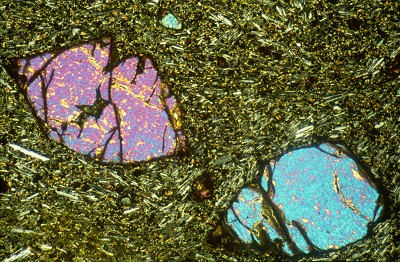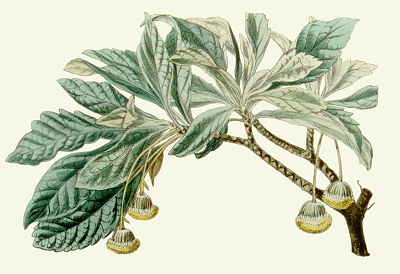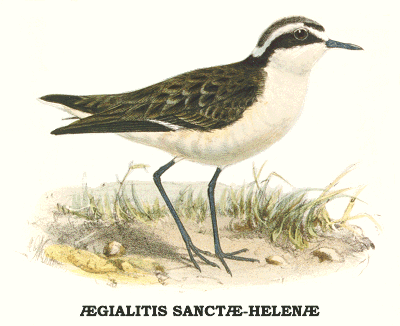Natural History of Saint Helena
Saint Helena has a fascinating natural history. Unfortunately, as is all too common on oceanic islands, the endemic flora and fauna has suffered the ravages of human habitation of the island; introduced animals and deforestation have almost completely destroyed the lush tropical wilderness described by the earliest visitors to St. Helena (only about 10% of the island is now covered by semi-natural forest). Encouragingly, there has been recent recognition of the importance of conservation and re-introduction of the endemic flora; the establishment of the Diana's Peak National Park, the gumwood reforestation project at the Millenium Forest, and formation of the St. Helena National Trust are very positive steps.
Geology
 St. Helena is a volcanic island although volcanic activity
has long since ceased. The last volcanic eruptions occurred about 7 million
years ago and since that time the island has been sculpted into its present
form by the forces of erosion. The sea has carved the sheer cliffs that
ring the island and streams have incised the deep v-shaped valleys.
St. Helena is a volcanic island although volcanic activity
has long since ceased. The last volcanic eruptions occurred about 7 million
years ago and since that time the island has been sculpted into its present
form by the forces of erosion. The sea has carved the sheer cliffs that
ring the island and streams have incised the deep v-shaped valleys.
The oldest volcanic rocks on St. Helena are about 14 million years old and are exposed in the northeastern part of the island and form the Northeastern Volcanic Centre which remained active until about 11 million years ago. At that time the centre of volcanic activity jumped to the southwestern part of the island where activity persisted until 7 million years ago; the volcanic products of the Southwestern Volcanic Centre have been divided into three separate phases of activity. The geological map shows the distribution of the different ages of volcanic rocks on the island.
Most of the eruptions produced the basalt lava flows which are so evident in the cliffs and valley sides of the island today. Lavas of higher silica content were also erupted, such as the thick trachyte flows now exposed on Turk's Cap and Little and Great Stone Tops. Explosive eruptions which produced pyroclastic deposits were rare. The final phase of activity involved intrusion of trachyte magma as dykes and pipes; subsequent removal of the more easily eroded enclosing volcanic rocks has left these trachyte masses as prominent features of the landscape in the southwestern part of the island (e.g., Lot, Lot's Wife, Asses Ears, Gates of Chaos).
Flora and Fauna
 When discovered in 1502, St. Helena was densely vegetated
and there survive a large number of endemic plants, including 14 endemic
species of fern and 6 endemic genera of flowering plants (with an additional
4 extinct genera). The flowering plants include the bizarre She and He
Cabbage Trees. There is an active propagation programme (involving Kew
Gardens) to save particularly threatened flowering plants such as the St.
Helena Olive, the St. Helena Redwood, and the St. Helena Ebony.
When discovered in 1502, St. Helena was densely vegetated
and there survive a large number of endemic plants, including 14 endemic
species of fern and 6 endemic genera of flowering plants (with an additional
4 extinct genera). The flowering plants include the bizarre She and He
Cabbage Trees. There is an active propagation programme (involving Kew
Gardens) to save particularly threatened flowering plants such as the St.
Helena Olive, the St. Helena Redwood, and the St. Helena Ebony.
 The original terrestrial fauna of St. Helena comprised
only birds and invertebrates. The Wirebird (Charadrius sanctaehelenae,
a plover) is St. Helena's only surviving native land bird, although fossil
remains have been found of five other endemic species. There is a Wirebird
population of approximately 500 with Deadwood Plain as the most important
breeding site. It is a protected species but threatened by habitat loss.
A variety of land bird species have been introduced. A modest sea bird
population is now restricted to breeding on isolated cliffs and rocks.
There are over 200 endemic invertebrate species, including the elusive
(and probably extinct) giant earwig Labidura herculeana, the largest
earwig species in the world.
The original terrestrial fauna of St. Helena comprised
only birds and invertebrates. The Wirebird (Charadrius sanctaehelenae,
a plover) is St. Helena's only surviving native land bird, although fossil
remains have been found of five other endemic species. There is a Wirebird
population of approximately 500 with Deadwood Plain as the most important
breeding site. It is a protected species but threatened by habitat loss.
A variety of land bird species have been introduced. A modest sea bird
population is now restricted to breeding on isolated cliffs and rocks.
There are over 200 endemic invertebrate species, including the elusive
(and probably extinct) giant earwig Labidura herculeana, the largest
earwig species in the world.
Comprehensive information on the flora and fauna of St. Helena can be found
in St. Helena and Ascension Island: A Natural History by Philip
and Myrtle Ashmole.
Page maintained by Barry Weaver